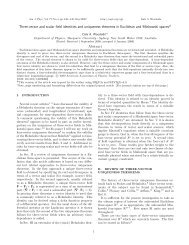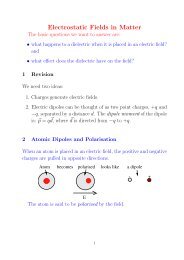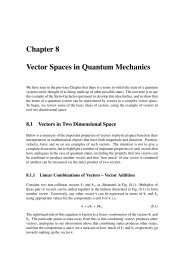AOS News - The Australian Optical Society - Macquarie University
AOS News - The Australian Optical Society - Macquarie University
AOS News - The Australian Optical Society - Macquarie University
- No tags were found...
Create successful ePaper yourself
Turn your PDF publications into a flip-book with our unique Google optimized e-Paper software.
<strong>AOS</strong> <strong>News</strong> Volume 25 Number 1 2011Figure 3. Experimental apparatus for tripletmanifold transition rate measurements.photon transition from the ground state,so consequently it has to be excited byelectron collisions e.g. in an electricdischarge.<strong>The</strong> metastable state is extremelyimportant not just because of its longlifetime, but also because of the largeamount of stored energy it contains –some 20 electron volts (eV) which againis the largest of any neutral atomic ormolecular species. <strong>The</strong> electron scatteringcross-section of the metastable state is alsovery large [3]. This makes the metastablestate an important species in discharges,light sources and atmospheric physicsbecause of its role as an energy reservoir.Metastable helium is also important inatom optics – the matter wave analogueof light optics where atoms can be lasercooled,manipulated and trapped at verylow temperatures. Ultracold atoms canbehave either as waves or as particles,because the lower the temperature, thelarger the de Broglie wavelength l dB(= h/mv , where h is Planck’s constant and mvis the atomic momentum) allows wavelikeprocesses such as beamsplitting (forinterferometry) to occur. <strong>The</strong> laser coolingtransition used to reduce the atomicvelocity by photon momentum transferusually starts from the atomic groundstate, but for helium this transition is inthe extreme ultraviolet (XUV at ~58.4nm). However, because the metastablestate can act as an effective ground state,this allows the use of infrared laser-coolingin the 2 3 P manifold via a 1083 nmtransition which is accessible to a numberof laser systems.This mechanism is used to efficientlylaser cool metastable helium, therebycreating an excited state species for usein atom optics. <strong>The</strong> large stored energy ofmetastable helium provides an additionaladvantage, since the metastable atomsare easy to detect using charged particledetectors. <strong>The</strong> stored energy is released onimpact, with the metastable helium atomsacting as “nanogrenades” that enablesingle particle detection.In the metastable helium atom opticslaboratories at ANU we have exploitedthese unique characteristics to performatom optics experiments, and to createBose-Einstein condensates (BECs)of ultracold atoms whose de Brogliewavelengths overlap to form a macroscopicquantum state. <strong>The</strong>se studies – in whichthe atoms are isolated in an unperturbed,ultrahigh vacuum environment – alsooffer excellent opportunities to undertakeprecision measurements on the tripletstate helium atoms.We have focused on measuring thetransition rates to the ground state ofboth the metastable state and the helium2 3 P manifold (Figure 2), whose energyintervals have been measured withgreat precision (1 part in 10 7 ) [4-6].However, the experimental results wereat considerable variance with theory[7,8] - by several factors of ten times theexperimental uncertainty - which appearedto provide a significant challenge to QED.Very recently, this discrepancy has beenpartially resolved by new calculations [9]which reduce the discrepancy to severalstandard deviations.<strong>The</strong> discrepancy with QED theoryprompted us to ask the question – dothe transition rates from these states tothe ground state also provide a sensitivetest of QED? Interestingly, the heliumenergy intervals are known to a high levelof accuracy (1 part in 10 7 ), whereas thetransition rates were either not known atall (in the case of the 2 3 P manifold), or toat best to within 30% for the metastablestate [10].We used the isolated environmentprovided by our BEC experiments (Figure3) to measure the transition rates. We firstdirectly measured the fastest transitionfrom the 2 3 P 1level to the ground state(~180 s -1 [11]) by measuring the decay ofthe atomic cloud when illuminated with1083nm light (P1) from the metastablestate. <strong>The</strong> decay rates of the metastablelevel (~7900 s lifetime) [12] and the 2 3 P 2level (~0.3 s -1 transition rate, excited byP2 light) [13] were then determined bymeasuring the XUV photon decay fluxusing a channeltron detector, relative tothe P1 flux decay. <strong>The</strong> expected 2 3 P 0leveldecay rate – predicted to be zero – was alsoconfirmed [13].<strong>The</strong> results of the helium triplet statelifetime measurements are shown inFigure 4, together with the experimentaluncertainties. <strong>The</strong> rates for the 2 3 Pmanifold were determined for the firsttime, while the accuracy of the metastablestate was improved to ~6%. In all cases theexperiments were in excellent agreementwith theoretical predictions, once againconfirming the validity of QED.<strong>The</strong> singlet manifold also presents anopportunity to use helium as a test bedfor QED theory. In an experiment inwhich I participated in at the US NationalInstitute of Standards and Technology(NIST), we measured the transitioninterval from the 1 1 S ground state tothe first (2 1 S) singlet excited state. Thisinterval can then be used to determinethe Lamb shift in the helium groundstate – reflecting the effect of vacuumfluctuations on this state. We measuredthis transition for the first time, butother measurements of the helium Lambshift using different transitions from theground state had been undertaken withvarying levels of precision (Figure 5) suchas the experiments of the Amsterdamgroup [Eikema et al. - 15].Our experiment aimed to improve onthe most recent previous measurementby using a Doppler-free two-photontransition to measure this single-photonforbidden, ultra-narrow lineshape. Weachieved a result [14] very close - withinthree (48MHz) standard deviations -from the Amsterdam measurement, andin similar reasonable agreement withtheory.<strong>The</strong> precision measurement cyclecontinues however, and more recentlyFigure 4. Ratio of experimental totheoretical values for the transition ratesshown, with experimental error bars.10
















